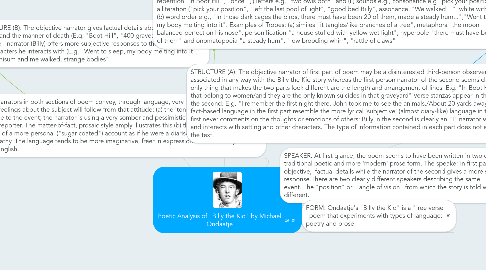Poetic Analysis of "Billy the Kid" by Michael Ondaatje
by Conrad DiDiodato

1. TONE AND MOOD: the narrators in both sections of poem convey, through language, very different attitudes toward the subject. Their feelings about the subject will follow from that attitude: (a) the 'tone' of part one of the poem is one of indifference to the event; the narrator is using a very somber and pessimistic style to describe "Billy the Kid" as if s/he were a reporter. The matter-of-fact, prosaic style amply illustrates this (b) the 'tone' of the second part, on the other hand, is of a more personal ("sugar coated") account as if he were a diarist or autobiographer and is looking for reader sympathy. The language tends to be more imaginative, freer in expression, less bound by the normal rules of standard English.
2. STRUCTURE (B): The objective narrator gives factual details about places, number of dead and the manner of death (E.g. "Boot Hill", "400 graves", "200 by guns" while the I-narrator (Billy) offers more subjective responses to the events, places and characters he interacts with (E.g. "Went to sleep, my body melting into it", "John Chisum and me walked, strange bodies"
3. STRUCTURE (A): The objective narrator of first part of poem may be a disinterested third-person observer who may or may not be associated in any way with the Billy the Kid story whereas the first-person narrator of the second seems clearly to be Billy himself. The only thing that makes the two parts look different are the length and arrangement of lines. E.g. "In Boot Hill there are only two graves that belong to women/and they are the only known suicides in that graveyard" Verse stanzas appear in the first part; verse paragraphs in the second. E.g. "I remember the first night there. John took me to see the animals./About 20 yards away..." Nor does the objective, fact-based language in the first part resemble the more lyrical 'subjective' (almost diary-like) language in the second. The narrator in the first never comments on the thoughts or emotions of others; Billy in the second is clearly an "I" narrator who is a character in the story and interacts with setting and other characters. The type of information contained in each part does not appear to conform to the form of the text.
4. POETIC TECHNIQUES: Schemes and Tropes (or Figures of Speech) in "Billy the Kid". Examples of Schemes in the poem: (a) repetition "In Boot Hill", "once" (i) letters e.g. "two owls both" and (ii) sounds e.g., consonance e.g "pick your position", alliteration ("pick your position", "left the last pool of light", "good bed Billy", assonance, "We walked", ""white with light"); (b) word order e.g., "In those dark cages the birds, there must have been 20 of them, made a steady hum...","Went to sleep, my body melting into it". Examples of Tropes: (a) similes "it tangles/like branches of a tree", metaphors "the moon balanced perfect on his nose", personification "a house stuffed with yellow wet light", hyperbole "there must have been 20 of them" and onomatopoeia "a steady hum", "low brooding whirr", "rattle of claws"
5. SPEAKER: At first glance, the poem seems to have been written in two distinctive forms: a traditional poetic and more 'modern' prose form. The speaker in first part is providing objective, factual details while the narrator of the second gives a more subjective response.There are two clearly different speakers describing the same "Billy the Kid" event. The "position" or "angle of vision" from which the story is told will be markedly different.
6. FORM: Ondaatje's "Billy the Kid" is a "free verse "poem that experiments with types of language: poetry and prose


